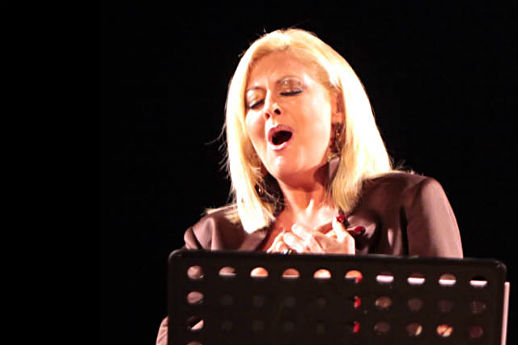

Signora Taigi’s had been a rather successful debut in L’Africaine, or at least that had been my impression. If you don’t believe me, ask La Divina Cieca as she, too, was at the event, perched in her perilously high stilettos, pencil sharpened and scribbling away furiously. This recital then, which was the Vidda Foundation Award Recital as presented by Opera Orchestra of New York, promised to be a closer look of an upfront and personal kind at this engaging and promising young soprano.
Or so I thought.
What I instead encountered was rather a bizarre night of audition showcase arias, songs and scenas, of radically differing types. Now, to be fair, and according to Maestro Queler’s programme note, the aria format was specifically requested by the good people of the Vidda Foundation. Even still, when was the last time you have heard the combination of Lodoletta’s pathetic plea “Flammen perdonami”, followed shortly thereafter not only by “Casta diva”, but then topped off with the Scena Ultima from Il pirata? Divine madness? Not exactly. And that is the least of it, as things became curiouser and curiouser still.
Let me start at the beginning, a very good place to start. The programme commenced with the entry of Ms. Taigi with her accompanist, none other than Maestro Queler, herself. As the soprano glided onto the stage with her platinum blonde hair loosely coiffed, and wearing a dark evergreen floor length satin gown, I noticed a type of mink stole arranged about her shoulders, dyed the exact same shade as the dark green of the gown. Coupled with the ultra-platinum blondined halo, the overall effect struck me not as it had likely been intended, i. e. as Glamour, but as something eerily unnatural and contrived for an effect whose reach had exceeded its grasp. (An aside: Ercole Farnese came to mind, knowing his displeasure in the sighting of the fur-wearing diva.) Wouldn’t a sumptuous Loro Piana cashmere, or an Hermes silk shawl have done just as nicely, I asked myself?
Green mink? For crying out loud, what would Edith Head have said?
The calling-card number was, in effect, the pathetic Lodoletta, an unusual gambit but for me an especially favourite guilty pleasure… notably as sung by Pia Tassinari, Renata Scotto, or Mirella Freni. Ms. Taigi’s rendition was acceptable and marked by its emotive, descriptive interpretative detail and she triumphantly managed not to go flat as most do in this aria. All right then, a decent, if not a thrilling start. She did look a little apprehensive—but who could blame her?
Next, we switched gears by abruptly leaving the italianate veristic idiom, her fur bedecked shoulders now braving the steppes of Georgia. She sang one of my favourite Rachmaninoff songs, “Do not sing, o Beauty, sad songs for me” (“Ne poy, krasavitsa, pri mne” and correct the transliterative spelling, Krunoslav, if it so pleases), which suited the dark and rather mournful timbre of her voice very well. An assisting artist, Erica Kiesewetter (concert mistress of OONY), came onto the stage to play a violin obbligato, a nice touch. Although an abrupt departure from Italian verismo, this song came off very well and showed a marked coming to grips with the voice by the artist. It also possibly gave the a clue as to the necessity of the fur–those frigid, desolate Georgian steppes.
All right then, next stop, Nagasaki! Yes, abruptly back to the Italian lyric veristic stage with the beloved and done to death “Un bel di, vedremo” from Madama Butterfly. The acting out of the aria’s descriptive detailing of Pinkerton’s return was well done if perhaps a bit much, in such intimate settings. The first of a series of alarm bells sounded for me when I saw her gulping for air right before the climactic B flat, at aria’s conclusion. A sour note, shrill and shrieky, the inevitable first sign of her constant intrusion of too much chest voice upon the higher notes (acuti).
Not to be daunted, we now travelled to ancient Gaul to invoke the chaste goddess of the moon, and to turn back in time to the Ur-arci-romanticismo of 1831 Bellini and that irresistible diva-magnet, “Casta diva”. As, patrolling the internet I have come across an example of her singing of this aria last year, in concert, I will allow you to judge.
A far more “live” acoustic in that concert hall, as opposed to that of the Weill Recital Hall helped out, I feel. A nice mezza voce was used in singing the opening phrases and those pesky turns which are splatted in any and all directions or generally approximated, were accurate. Other than an extra breath taken in the series of repeated A’s before the culminative B flat, a rather fluent account of this formidable aria, if not that reminiscent of a full moon-lit night in an oak grove. Somehow or another this cavatina came out better than the Butterfly excerpt—mirabile dictu!—as it is generally the other way around.
After applause for the Lunar Invocation, Ms. Taigi left the stage and another assisting artist, Ms. Melanie Feld, English hornist, accompanied by Maestro Queler, played the glorious opening phrases of Bellini’s “Col sorriso d’innocenza” from the 1827 landmark, “Il pirata”, one of the first successful “mad scenes” and a real tour de force, not to mention another of my guilty pleasures. The English horn is so critical in establishing mood and tone of this scena that I was grateful for the thoughtful preparation of Maestro Queler’s.
Of course as all you Callas queens know, this scene will never be bettered by anyone else! Well, maybe Caballe, but I’ll let you all pull each other’s hair on that one.
Ms. Taigi appeared on stage again, looking notably consternated and slightly like Our Beloved Madame Vera does when she makes an entrance, and launched into a surprisingly successful account of first, the cavatina (without the Caballe/Callas diminuendos and cadenza interpolations) and a very good, if truncated accounting of the fearsome cabaletta, indulging her chest voice in the lower portions, to her fullest contentment. As the climactic note is a C, I was worried about that note but it issued forth all right, as in the first instance it comes by an ascending scale, so the climactic final cry had been secured by the first foray upwards. As Imogene’s plight is sorry indeed, well, an hysterical cry, rather than an elegantly sounded note, is not entirely out of context.
As there is many a Butterfly ascendant in the opera heavens, the fact that she could manage the complicated dramatic fioriture of the cantilena belliniana was heartening to me. Also, her stark dramatic instinct was well used in the depiction of Imogene’s madness, if only slightly veering off into Galupe-Borszkhian territory. At any rate, I was grateful to have heard this wonderful scene, too rarely done.
After a brief intermission, Ms. Taigi reappeared on stage. There had been, in true diva fashion, the requisite change of costume. Thankfully, she had shed the green fur piece. Now she wore a very severe long-sleeved black and white floor length costume. I don’t quite know what effect she was going for but it had a nun’s habit or penitentiary aspect to it, rather severe even for concert stage. A long white sash trailing down to one side seemed to be there as a sort of lifeline by which she could be pulled back to a safe shore.
At this point we were again treated to an Italian opera excerpt, and in my opinion, the most entirely successful one, “Morro, ma prima in grazia” from Verdi’s capolavoro, Un ballo in maschera, with another assisting artist, Eugene Moye at the cello, playing obbligato. In this instance Ms. Taigi seemed to me to be singing with the most fully integrated voice, no chesty sounds and a fluent line. The attack of the cadenza at the end on the C flat was not bad but she swiftly went down into its descending line to land smack back into the full frontal chest voice she so favours and had avoided until then, but did manage to neatly come back up to close the aria with a lovely, long diminuendo, held along with the cello, to create a marvelous effect. This aria eliciting many bravos (sic). It helped, no doubt, that she had recently sung Amelia in Ballo, and apparently successfully, only just last week in New Orleans.
Now we leap continents and genres—to make the mother of all understatements— to travel to Brasil…? Well, that is what the programme says, “Estrellita: Canzone Brasiliana”!!! Poor Mexico: like Rodney Dangerfield it just doesn’t get any respect! As Manuel Ponce is one of the most famous Mexican composers and his song “Estrellita” his most famous and beloved of all works, I would not have been so perturbed by the “Brasiliana” mistake had it been an obscure Maria Grever song termed “brasiliana” and it should rightfully have said “Cancion mex(j)icana”.
Well, cher readers, this is the climactic turning point when everything slid south—and not just south of the equator “down Mexico way.”
As she began the song (with a teensy South American pronunciation but otherwise good Spanish), she all of a sudden our primadonna went down the stairs off the stage and began singing to various gentlemen in the audience, one in particular, who shall re-appear later. It was all, suddenly last summer, as if we had been magically transferred to the Fontainebleau Hotel on Miami Beach! Well, why not? We’d already traversed the steppes of Georgia, the shimmering druidic groves of Gaul, the hilltop homes of Nagasaki, the palazzi of medieval Agrigento—why indeed not South Beach Salsa, as well?
I dunno, cher reader, how “Estrellita” got into the mix but it must needs be a favourite of someone in the Vidda Foundation. That is the only way I could explain it and its nightclub style presentation. Next stop—Boca Raton Century Village—hey there, you scoffer, if it’s good enough for Charo, it’s good enough for anyone else with chuchi-chuchi!
Now for the finale! What is the obvious follow up to “Estrellita”? Why naturally, that would be a partially sightread “Pace, pace, mio dio”!!! Well, at least the penetential nun’s garb she had on looked appropriate in this number. Sung in a similar manner as the others with another blaring B flat, screamed out as best she could.
Oh merciful heavens, it was over!
Nicht doch! Then came the encores!
Fleeing Leonora’s grotto and flaying for her life, la Taigi gave us, with yet another guest artist, this time a different accompanist, a Mr. Seth Farber (who was in the vent a terrific song stylist and accompanist), relieving Ms. Queler who fled the stage amidst modest protestations that she “couldn’t play that kind of music! Oh gawd, what kind of music are we about to hear? Alban Berg? “Coal Miner’s Daughter?” A bossa nova actually from Brasil?
No, cher readers, it was Gershwin’s “The Man I Love”. Once again, Ms. Casta Diva descended from her dais to serenade, South Beach style, the elder gentlemen of the audience, zeroing in on one corpulent package in particular. I wanted to stand up and shout “Get a room!” Suddenly the Casta Diva had turned into Billie Holiday!
After this song styling, and it was very good indeed, in nearly perfect English and with the voice smooth, supple and elegant, no chest hanging blaringly out, there was a little speech by her and “the man I love”, who blathered on with a lot of stuff I blocked out as I had long since retreated to my “Safe Place”. After the palavering was over and she had placed him in a seat next to her, on stage, and abruptly went back home to Rome (she is, in fact una romana) and ended the night’s festivities with the Roman Diva par excellence, Floria Tosca, and an average accounting of “Vissi d’arte”, the by now familiarly blaring B flat furled out like a proud, war torn banner, once more. All the while holding on to Baron Scarpia’s hand as she sang. We were waved goodbye and dismissed rather as if at a school assembly.
Poor old Camille was left so dazed and confused by all the above she sought counsel with Mamma Grizzly Cieca, who advised her to write it all down, as a purgative. So here it was.
I’m just no longer sure of Ms. Taigi and what she is about. Apparently, you Londoners will be hearing her in the 2012-13 season as Aida, presumably at Covent Garden. This particular debut was the stated reason why she was unable to accept an offer from the Metropolitan to sing in this season. What does 2012-13 have to do with this season? Thereby becoming curious, I consulted the magical oracle of Operabase, where upon accessing her name, I found nothing listed beyond the 12th of December concert I’d just heard.
To sum up, Chiara Taigi is a stage animal. She has an expressive voice. She is House of Gelb camera-worthy (thank you, NN). She really has it all except that thing no singer can really do without, the “ligne de chant” (thank you, oedipe). She tries too hard for arty effects before establishing a real, even, and dynamic line that projects easily into the house. As I said above, the Weill Hall acoustics were probably not accommodating to her voice. Therefore, one is left hanging, much as one does with Poplavskaya, wondering what will happen on every note.
As Daniela Dessi and Barbara Frittoli, the only Italian sopranos of rank who regularly export to the States are now at their respective sell-by dates, I had set great hopes on this lady, from her one appearance in AF Hall as L’Africaine. Now I think, unless she learns to sing more cleanly and evenly, it is possible that her shelf life may be similarly limited and that is a shame. Perusing an extended scena of the finale of Suor Angelica, which she sang for RAI with Riccardo Chailly, I have jolted into an awareness of those constantly effort-filled and screamed out high notes. Of course, bad singing never stopped anyone, if they want to just emote. Look at Billie Holiday. Somehow, though, I think I’d rather listen to Billie, ’cause even senza voce, what she manages to communicate seems somehow more “real” to me, whereas Signora Taigi is teetering troublesomely over into the land of self-parody. A land already inhabited and expertly handled by the magnificent Madame Vera, who expresses in her parody, her palpably real and profound love and devotion to her Art.
For now, I’ll stick with Madame Vera when I want to see Divine Madness. At least, she’s the Real Deal. I’m sure you’d never catch her in a saloon in South Beach, or God forbid, Boca Raton, America’s rudest city.
Thank you for your attention, all my many dear associates of parterre, and my even more numerous frenemies and enemies. Camille has now taken her purgative and feels better and will now recline in the sanctity of Leonora’s grotto, which she has spruced up to resemble Venusburg. Hey, why not? It’s a do-what-you-feel-like-doing kinda world these days, innit?























Comments